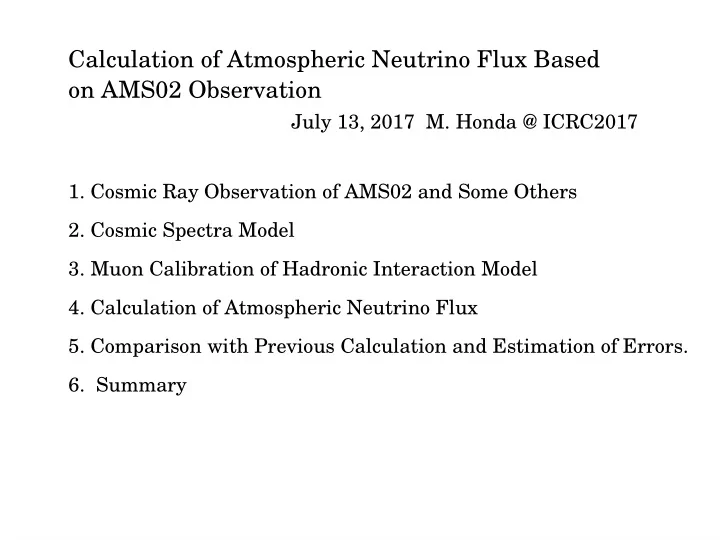

Calculation of Atmospheric Neutrino Flux Based on AMS02 Observation July 13, 2017 M. Honda @ ICRC2017 1. Cosmic Ray Observation of AMS02 and Some Others 2. Cosmic Spectra Model 3. Muon Calibration of Hadronic Interaction Model 4. Calculation of Atmospheric Neutrino Flux 5. Comparison with Previous Calculation and Estimation of Errors. 6. Summary
Primary Cosmic Ray Model and referred data (2004) Other chemical compositions are also considered in the calculation, but they give small contributions.
Direct Observation Balloon Borne (BESS) Satellite (ISS, AMS02)
Recent Cosmic Ray observation and Available High Energy data
Proton Closeup
Helium Closeup
Cosmic Ray Spectra Model Based on AMS02 Observation Looking forward to hearing from CALET and ISS-CREAM
Solar Modulation and Neutron Monitor
Solar Modulated Flux at Fixed Energy
Practical Formula for Solar Modulation Where a is from right figure, and N is the Count of Newark Neutron Monitor.
Muon Calibration Primary cosmic ray flux Interaction model Calculation scheme (include rigidity cutoff) Atmosphere model
Muon Calibration of Interaction Model Quick 3D Calculation for Muon flux. As the muon flux is a “local quantity” ( γ c t 〜 60km at10 GeV ), We can calculate it in a quick calculation method: 1. Inject cosmic rays just above the observation point, 2. Analyze all muons reach the surface of Earth.
Comparison of Quick 3D and Full 3D calculations + − μ μ Full 3D Quick 3D This method works above 0.2 GeV/c.
Muon Calibration of inclusive DPMJET-III Data are larger by ~0.05 Data are larger by ~15% ~15% scatter ? Data are smaller by ~0.05 ==> DPMJET-III Should be Modifjed
Comparison AFTER the modification
JAM + Modified DPMJET-II vs Muons at the Balloon altitude ( HKKM2011) Use DPMJET-III above 32 GeV Good agreement ! and JAM below 32 GeV
With Cosmic ray spectra model based on AMS02 observation After muon re-calibration Before muon re-calibration
Full 3D-Calculation Simulation Sphere (Rs = 10 x Re) Cosmic ray go out this sphere are Re = 6378km discarded. Cosmic rays go beyond are pass the rigidity cutofg test Injection Sphere (Re +100lm) Cosmic Rays are sampled and injected here Virtual Detector The neutrino flux is calculated from the number of neutrinos path through with virtual detector correction.
Atmosphere Model Air density comparison with MSISE90 US-starndard'76 may be used as the global approximation of the Atmosphere.
Atmosphere model (NRLMSISE-00) and seasonal variations INO site Kamioka South Pole Near North Pole (Physalmi)
IGRF10 Geomagnetic Horizontal Field Strength
Based On AMS02 Obervation (Preliminary)
Estimated Error in Atmospheric ν -flux Calculation (HKKMS07) Possible Error with JAM (HKKM11) -observation error + Residual of reconstruction Kaon production uncertainty K Mean free path (interaction crossection) uncertainty Atmosphere density profule uncertainty air
Summary ● According to the new cosmic ray data provided by AMS02 and some others, We have renewed the Cosmic Ray Spectra Model including the practical formula for the Solar Modulations. ● The Muon Calibration of Hadronic Interaction Model was repeated again, with the newly constructed Cosmic Ray Spectra Model. ● The atmospheric neutrino flux calcuoated with New Cosmic Ray Spectra Model and the Muon-Calibrated Hadronic Interaction Model wit it is generally similar to the previously calculated one, considering the difference of the Muon-Calibration Policy. ● However, a ~ 5% deficit of the flux at ~ 10GeV is seen in the newly calculated atmospheric neutrino flux irrespective of arriving directions or kind of neutrinos.
Comparison with Neutrino Data
From K.Okumura in ICRC2015
Solar Modulation of Atmospheric Neutrinos From PHD thesis of E. Richard Poor Statistics Best fit corresponds to 62 % of the predicted variations Picked up mainly the forbush decrease ?
ν e Observed Azimuthal Variation of flux (from PHD thesis of E.Richard) Energy Binned All Azimuth angles Zenith Angle Binned All Energies
ν μ Observed Azimuthal Variation of flux (from PHD thesis of E.Richard) air Energy Binned All Azimuth angles Zenith Angle Binned All Energies
Comparison in [Flux/depth] DPMJET-III show the best agreement
Phase Space Study ± + X p + N ( air )→ π ± → ν μ (̄ ± π ν μ )+ μ ± → ̄ ± μ ν μ (ν μ )+ ν e (̄ ν e )+ e P ν = 0.32 At GeV/c
p N air X Size of Phase space to give the variation P μ = 0.32 At GeV/c
Vertical neutrino flux e e
Horizontal neutrino flux e e
Horizontal enhancement of neutrino fmux (Battistoni et al. Astropart. Phys 1999)
Interpretation of horizontal enhancement Longer integration length in the neutrino production zone for horizontal directions
Recommend
More recommend